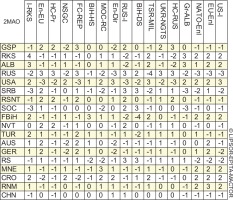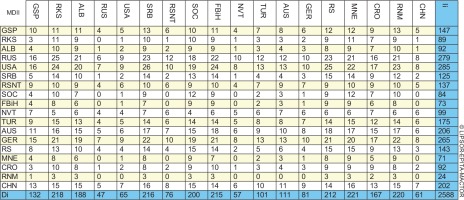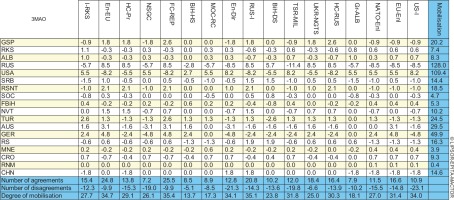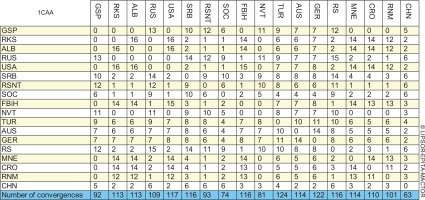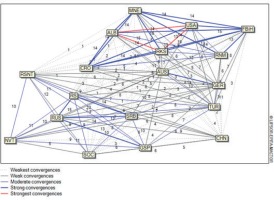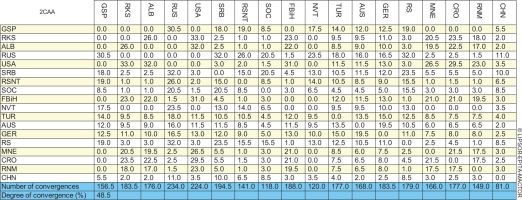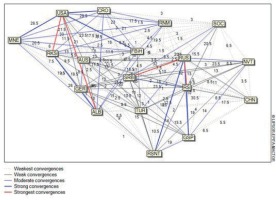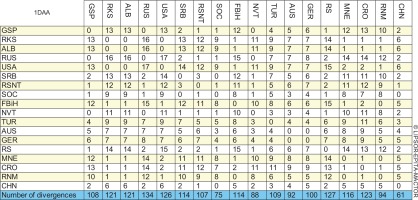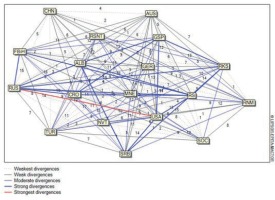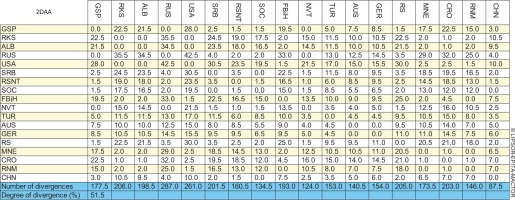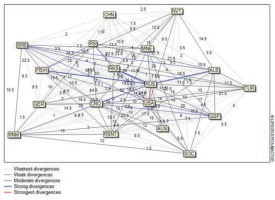Introduction
The complicated security environment arising from the behaviour of the Russian state heightens the significance of the Western Balkans region as a field of competition or even future direct confrontation. Both state and non-state actors are becoming Moscow’s proxies, further strengthening and exploiting existing division lines in the region. Certain media outlets with the support of key political and religious figures are used to carry out information-psychological operations aimed at distorting public opinion on issues of particular interest. Todor Kolarov points out the complex connections between unexplained wealth and different forms of criminality (Kolarov, 2020), and it should be noted that the implementation of proper mechanisms for counteracting this are key for improving the resilience of Western Balkan societies against such operations. It is also important to stop assets derived from criminal enterprises from being integrated into the formal economy (Kolarov, 2022). This problematises the need for a deep understanding of the processes taking place in the region.
The article gives an insight into the interplay between the main actors and aims to clearly define important relationships which predetermine possible pathways for the evolution of the Western Balkans as a system. The research hypothesis consists of the following statements:
the structure of the region is subordinated to a single major divergence;
insulator states are playing a mediation role;
the focal point of polarity is in Bosnia and Herzegovina (BiH), threatening the sole existence of this state.
The research strategy relies on the implementation of MACTOR software developed by Laboratoire d’Investigation en Prospective, Stratégie et Organisation (LIPSOR) and École Pour l’Informatique et les Techniques Avancées (EPITA). This computer-assisted method makes it possible for key convergences and divergences regarding several important stakes and objectives related to them to be stated (Godet and Durance, 2011, p. 69). As a result, potential alliances and conflict areas are outlined for each actor.
The significance of the study arises from the need to derive the structural phenomena in international relations subsystems. Since the 1950s, mathematical modelling has occupied a pivotal position in the effort to optimise decision-making processes on different levels, but its methods of game theory remain burdened by the diversity of the environment (Johnson, 1989, p. 400). Most of these efforts are therefore limited by their scope or the difficulty of producing operable results. Furthermore, such recent studies have been more focused on the easier to measure economic performance of states (Bigo and Negru, 2014; Orekhov et al., 2020) or have elaborated on their internal political dynamics (Brody, 2019).
These impediments have had an impact on this study, the results of which are highly dependent on the input of the actors and objectives. Nevertheless, the structural relations produce implications that exceed the analysis of a single region and may be used for further development of the conceptual apparatus, especially with regard to drawing a typology of regional spaces (with inherent nature and specific structure).
Context
After Russian aggression became more overt, the future behaviour of the Serbian state clearly set itself as a key switch-factor for the vertical structure of the Western Balkans, as well as for the prevailing relations narratives. While Aleksandar Vucic expressed his pride at his unprecedented political success in the general elections held on 3rd April 2022 (Novosti, 2022) (despite parliamentary elections being held five times in Veliki Trnovac, the last on 30th June 2022), Serbia is faced with the need to legitimise its European perspective through its actions. The blocking factors in this regard can be split into the following three areas:
Public attitudes – 76% of respondents in a survey conducted by the Institute for European Affairs and “NinaMedia” (in the period 04–14 March 2022) consider the Russian Federation to be a friend of Serbia. Only 13% support adherence to the EU’s decision to impose sanctions against the Russian state (Jovovic, 2022). This is a very indicative condition as social capital is being built upon trust, interaction, and cohesion (Gaidarov, 2018, p. 43).
Political and economic dependence – the Serbian Progressive Party (SPP) and the Socialist Party of Serbia (SPS) could hardly transform their attitude towards the Russian leadership without losing electoral support. This is reinforced by the possibility that Russia may change its position on Kosovo and/or shift its support to other domestic political players. The objective dependence in the energy sphere, expressed in the majority control of “Gazprom” over “Naftna Industrija Srbije” (51%) and over the underground gas storage facility “Banatski Dvor” (56.15%) through the subsidiary company “Gazpromneft” (Danas, 2022a), significantly limits the manoeuvring space for those in power in Belgrade.
Great-state ambitions – the SPP still sees its progenitor as far back as 1881 and revanchism is only stifled by a lack of capabilities. This leads to prioritisation of hybrid methods aimed at eradicating minorities and promotion of false identities, including through the active participation of the Russian state and church. All of this threatens the stability of the Republic of North Macedonia (RNM), BiH, Montenegro and Kosovo.
In the context of election violations and incidents (CRTA, 2022a, 2022b), the Serbian state maintains its foreign policy course, which diverges from Euro-Atlantic values. Serbia’s main interest remains in guaranteeing the supply of Russian natural gas along the “Turk Stream” – “Balkan Stream” route. The statement of the general director of “Srbijagas” and former member of parliament from the SPS list, Dusan Bajatovic, is quite indicative as he defines the intention of the Bulgarian state to refuse to negotiate a new contract with “Gazprom” as “empty dreams” and “political statement” (Politika, 2022). The President of Serbia also expressed his position on the matter: “Bulgaria has said that it will stop importing (Russian) gas, I am not sure it is that easy … we want Russian gas from “Turk Stream”, deliver it to our pipeline, we pay for it, and what you want is your business” (N1, 2022).
According to Bajatovic, Serbia (as of March 2022) secures 50-60% of the supplied quantities of natural gas via the “Balkan Stream” which in turn creates a significant vulnerability towards the Bulgarian state. The current European Network of Transmission System Operators for Gas (ENTSOG) data shows that deliveries (from Hungary to Serbia) through interconnector “Kiskundorozsma” (EIC: 21Z000000000154S) have been suspended since 5th May 2022 (ENTSOG, 2022). This situation, along with Vucic’s desire to demonstrate to the US and the EU an apparent convergence of positions without actually disrupting the Russian-Serbian axis, supports the thesis that the Serbian side has no interest in the development of alternative routes for natural gas supplies. Vucic’s presence at the beginning of the construction of the regasification terminal near Alexandroupolis might be perceived as demonstrative with an inherent risk for future speculative behaviour with a view to destabilising the regional energy market.
The capacity of the floating storage and regasification unit (FSRU) (5.5 bcm/y) is insufficient to fully meet the needs of the countries in Southeast Europe. The possibility of exchanging quantities of natural gas between Turkmenistan and Azerbaijan, with the mediation of Iran, is promising. On 29th November 2021, an agreement was signed for the exchange of up to 2 bcm/y (Mehdi, 2021). In this way, it is possible to increase the quantities exported from Azerbaijan, including via usage of the free transmission capacities on the territory of Turkey – about 4-5 bcm/y (O’Byrne, 2022).
Aleksandar Vucic points out the desire of Serbia to continue following a European integration path without this being at the expense of “relations with traditional friends” (Topportal, 2022), and in issue 3718/31st March 2022 of “NIN” magazine (NIN online, 2022) information appears (based on video material published by the Ukrainian Ministry of defence) refuting the Serbian president’s claim from November 2019 that only one shipment of anti-personnel mines was delivered to Ukraine in 2016.
In parallel, the provocative behaviour of the Serbian Orthodox Church (SOC), clearly outlined by the statement of Metropolitan Joanikije that “it is even envisaged that Montenegro will be a small Ukraine” (Danas, 2022b), was supplemented by the act of recognition of the Macedonian Church as autocephalous (RTS, 2022) (the intention to do so was expressed by the Serbian Patriarch Porfirije on 24th May 2022, during his visit to Skopje).
Serbia continues its efforts to strengthen the “Open Balkan” project. At a meeting of the initiative in Ohrid, held in the period 07-08 June 2022, the Prime Minister of Montenegro Dritan Abazovic and the Chairman of the Council of Ministers of BiH Zoran Tegeltija were present as observers (Vox, 2022). Of interest are the comments of Sergey Lavrov, who believes that his failed visit to Serbia is tied to “the reluctance of the collective West to provide Moscow with an opportunity to demonstrate support for this project” (Balkanist, 2022). According to the Russian Minister of Foreign Affairs, the “Open Balkan” project is against the interests of the EU and NATO.
The EU’s aspirations to change the foreign policy line followed by the Serbian state remain unfeasible (Bakalov, 2020, pp. 466–467). Vucic, both in his speech before the Assembly at the beginning of his second presidential term (31 May 2022) (Srbija realno, 2022) and in his speech at the International Fair in Novi Sad (21 May 2022) (BGNES, 2022), emphasised that “his task as president is to take care of Serbia, not the EU”. At a joint press conference with Olaf Scholz (10 June 2022), the Serbian president expressed his disagreement with his guest on the issue of sanctions against the Russian Federation and the recognition of Kosovo’s independence. Vucic compared the Russian invasion of Ukraine to NATO’s Operation Allied Force (1999), adding “please, explain to me the difference” (Politico, 2022). In relation to Kosovo, he points out that “we do not react to pressure when someone threatens us”.
On 29 May 2022, the Serbian president announced that during a telephone conversation with Vladimir Putin, he had reached an agreement to sign a new three-year contract with “Gazprom” (the previous contract expired on 31st May 2022). Delivered quantities are expected to be 2.2 bcm/y with price in the range of USD 340-350/1000 cubic metres (Ozturk, 2022b). Meanwhile, on 25 May 2022, talks were held with the chairman of the American “Export-Import Bank”, Reta Lewis, to provide a loan to finance the development of energy projects: solar parks and hydroelectric facilities (Srbin.info, 2022).
In the current situation, the energy issues keep their role as a key driver for the strategic line of behaviour followed by the rest of the Western Balkan states. While Albania is investing in the development of natural gas storage capacity (“Dumrea”) with the ambition to become a distribution hub for the flows from the Caspian region, it remains (along with Kosovo and Montenegro) one of the only countries in Europe that does not have existing cross-border gas interconnectors. At a joint governmental session in Pristina (20th June 2022), Kosovo and Albania signed two memorandums on cooperation in the field of energy (Todorovic, 2022). State energy companies Korporata Energjetike e Kosovës (KEK) and Korporata Elektroenergjitike Shqiptare (KESH) agreed on electricity exchange, storage and diversification of energy sources. The other memorandum is aimed at cooperation for the construction of a liquefied natural gas (LNG) regasification terminal in Vlora (a project of the American companies Excelerate Energy and ExxonMobil).
The FSRU (with a capacity of 4.83 bcm/y), after the expiry of its current contract (until the end of 2022) to service the “Hadera” terminal in Israel, is expected to move to its new location and begin operations there in the second half of 2023 (LNG Prime, 2022). The Minister of Economy of Kosovo, Artane Rizvanolli, expressed a preference for the purchase of secondary energy (in the form of electricity) instead of the development of the gas transmission infrastructure between the two countries, which practically means rejection of the construction of the Albania - Kosovo (ALKOGAP) gas pipeline (Todorovic, 2022).
BiH remains entirely dependent on Russian natural gas. Furthermore, the Russian state company “Zarubezhneft”, via its subsidiary “Neftegaz InCor”, owns 80% of Brod refinery, 75.65% of the refinery in Modrica and 80% of the shares of the fuel trader “Nestro Petrol” (Neftegaz.RU, 2017). Since 7th April 2021, the country put in operation a new route for the delivery of natural gas – instead of the one via Ukraine, Hungary and Serbia, it started using the route Turkey – Bulgaria – Serbia (Neftegaz.RU, 2021). This plays out in the context of increasing demand over the last 2 years (235.56 mcm in 2019, 213.79 mcm in 2020, 261.53 mcm in 2021 and 135.68 mcm for the period January – May 2022) and lack of diversification.
In order to guarantee access to non-Russian natural gas, the southern interconnection point (IP) Zagvozd – Imotski – Posusje – Tomislavgrad – Novi Travnik with a branch to Mostar, should be constructed. This project planned by “BH-Gas” and “Plinacro” is facing significant resistance from the Republika Srpska leadership. On 17th June 2022, Milorad Dodik stated that all energy diversification projects of BiH will be blocked until permission is received for the construction of the eastern IP (Bjelina – Banja Luka – Prijedor – Novi Grad) agreed by “Srbijagas” and “Gas Res” in March 2021 (Ozturk, 2022a). At a meeting of the Council of Ministers of BiH, held on 5th July 2022, the strategically important issue of building the southern IP with Croatia was not included in the agenda, due to its joint proposal for consideration along with the issue of implementing the eastern IP (this was made at the insistence of the Ministry of Industry, Energy and Mining of Republika Srpska and set as a condition for subsequent provision of support by the government of this entity) (Klix, 2022).
Parallel to RNM’s ambitions to abandon the use of coal for electricity production, its natural gas consumption marked an increase of 115.25% for the period 2017–2021. The country is entirely dependent on deliveries through IP Kyustendil – Zidilovo, the full capacity of which is booked by “Gazprom” until 2030 (Sabadus, 2022). Currently, the development of gas infrastructure connectivity along the north – south axis, despite being an option for diversification, is highly unlikely to see significant improvement (with the exception of IP Evzoni – Gevgelija which will serve the internal gas market and is expected to become operational in June 2024).
Montenegro remains out of the reach of Russian natural gas but its plans for future development of gas-based electricity production capacity highlight the need for exploitation of homeland reserves. On 14th June 2022, Ilija Pjescic, executive director of the port of the city of Bar, stated that a memorandum of understanding was signed with the Singaporean company “LNG Alliance Pte Ltd”, regarding the construction of a regasification terminal and a steam-gas power plant with a capacity of at least 100 MW (in which the state electricity company will also be a partner) (Mirjacic, 2022). Furthermore, “Elektroprivreda Crne Gore” (EPCG) plans to build plants with combined steam-gas technology at the aluminium plant in Podgorica (capacity of at least 150 MW) and in Pljevlja (capacity up to 200 MW), along with a hybrid power plant near Bar (based on the operation of a gas turbine) with a capacity of at least 50 MW (Vujasin, 2022). It should be noted that the country seeks to fuel this capacity with locally extracted natural gas but so far “Energean” fails to find economically viable deposits (and even a partner to carry out the exploratory drilling operations). Previously, in 2021, the Italian-Russian consortium “Eni – Novatek” also failed in this task. Considering the above, Russia would strive to promote the construction of IP between Serbia and Montenegro (near Prijepolje).
Methodology and implementation
The modelling effort of a complex system such as the region of the Western Balkans inevitably inherits limitations arising from the need to omit certain actors (depth of decision-making cycle) and objectives which may be perceived as stages towards the final ones. The selection of external actors is carried out through a survey of experts, conducted in November 2021 (Table 1). Actors receiving more than the average score (9.6) are included in the model.
Table 1
Selection of external actors.
It should be noted that supranational entities, such as EU and NATO, are not included as separate participants due to the difficulty of quantifying their interactions. The interplay within their institutional bodies significantly influences the security and foreign policy of each member state, but there is low measurability of the extent to which this is playing out. Such major limitation of the research is alleviated by including the role of the EU and NATO in the objectives, both allowing for a more precise representation of constituent countries’ behaviour, as well as setting out the “soft power” mechanism of propagating stability and cooperation. BiH’s entities are also included separately in the model to ensure the results are more relevant. Thus, the input of the MACTOR software consists of 18 state/non-state actors and 17 objectives (Tables 2, 3).
Table 2
List of actors included in the model.
Table 3
List of objectives included in the model.
The following objectives are derived on the basis of the presented context and prior research of the author. Their inclusion provides for the deduction of cross-links and comparison of relative weights of actors with a different valence towards the objectives. The demographics dynamic in its role of a key driver for security production (Georgiev, 2020) is also considered.
It should be noted that the objectives related to influence also include the sovereign debt dimension. As Gergana Yordanova states, we should keep in mind that as such, the debt is a strategic financial superiority (domination) and even a psychological ascendancy by a lender to a borrower due to the current economic weakness of the latter and he being incapable of guaranteeing his own security with all the available resources (Yordanova, 2018). It is worth mentioning the arising secondary risk to the societal security which, in certain cases, could facilitate radicalisation processes, both religious and political (Yordanova, 2021, pp. 174–175).
In this regard, efforts to strengthen human security are significant. According to Dafinka Sidova, appropriate tools may be derived from the implementation of projects for cross-border cooperation (Sidova, 2019a), including those aimed at combating crime, especially among the younger population (Sidova, 2019b).
The implementation of the computer-assisted method is carried out by initial valuation of the Data/Matrix of Direct Influences (MDI) in which relations between actors are represented from row to column, according to the following codification (Table 4) (Godet and Durance, 2011, p. 70).
Table 4
Codification for valuation of MDI.
MDI contents are presented in figure 1 with emphasis on the dependencies from state to non-state actors, including through financial mechanisms.
Figure 1
Valuation of MDI for formalised presentation of the competitive space in the Western Balkans.
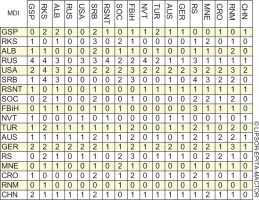
The input of the MACTOR method includes the Data/Matrix of Actors and Objectives (2MAO) which sets the valence and weight of each actor-objective pair (Figure 2). The codification is identical with the one included in Table 4, with minus signs highlighting undesirable developments in the security environment. Thus, a positive evaluation indicates a beneficial effect (with the above levels of intensity) relative to the reference subject. As a result, 2MAO allows the delineation of conflicts between the actors but also of neutral relations.
These inputs are sufficient for MACTOR to produce the Matrix of Direct and Indirect Influences (MDII) (Figure 3). The indirect influence is of a potential nature and comes down to the possibility for actor A to influence actor B by influencing an “intermediary.” In this matrix, second-order influences are introduced. The calculation of the results is performed as follows:
MDIIij = MDIij + ∑kMin(MDIij, MDIik),
where “MDIij” refers to the direct influence actor i has on actor j and “∑kMin(MDIij, MDIik)” represents the sum of all indirect influences actor i exerts on actor j, and which flow through an intermediary actor k (up to the second order, i.e. only one intermediary actor at a time) (LIPSOR-EPITA-MACTOR, 2004). The net direct and indirect influences of the respective actor (Ii) are calculated taking into account the influences it is receiving from other actors (excluding retroaction).
The results of the implementation of MACTOR demonstrate a high degree of accuracy in determining the relationships through which the included actors are integrated in the modelled system. The behaviour of the major Russian energy companies complements the overall formalised presentation and has the role of corrective tool for the interpretation of the security environment in the region. All internal (geographically integrated) actors propagate lower influence both within and outside the system. Three state pairs are formed which, although with different combinations of characteristics, are at a relatively equal distance from the intersection of the average values for influence and dependence: Turkey – Austria, China – Germany, Russia – USA. This is an indicator of the realistic setting of ambitions for counteraction and delineation of main competitive lines in the Western Balkans.
The correct interpretation of the data requires the introduction of the competitiveness index (R) of the actors (Figure 4). It is calculated by the software according to the formula:
where S = ∑i, and Ii = ∑I Di. Ri takes into account actor i’s manoeuvre range (Ii – MDIIii), in other words its net direct and indirect influence (Ii) minus its retroaction MDIIii (LIPSOR-EPITA-MACTOR, 2004). The relative manoeuvre range is then deflated by the coefficient Ii / (Ii + Di) which is between 0 and 1 and allows the actors dependence in the equation to be integrated. The Ri value is compared to 1: if an actor has a competitiveness value of more than 1, it is more competitive than the average and vice versa.
The derivation of R for each actor provides for a more precise comparison and outlining of general trends with respect to any given target. It should be noted that in this case, the character of the coalitions that are being formed is not revealed but only the direction of the observed behaviour in the competitive space. In this way, potential lines of enmity and amity are again formulated without inherent higher probability for the occurrence of such states.
The high number of divergences is a clear indicator of a distinct particularisation of interests in the corresponding segment of the competitive space. This overall pattern of the modelled system is further substantiated by the Weighted valued position matrix (3MAO). It emphasises competitiveness and the integration of three dimensions of valuation: the position relative to each target, its place in the overall hierarchy of targets for each participant and the relative weight compared to the other entities in the system. The results are derived based on the following formula:
3MAOij = Ri x 2MAOij,
i.e., multiplication of values from the actors and objectives matrix by the competitiveness vector value of each actor originating from their indirect influences (Figure 5).
Mobilisation rate values are key to defining goals that engage the actors in a more substantive way, as well as to present their overall footprint on the system. In this way, not only the expected opportunities for imposing one’s own projection for the future for the relevant subjects are outlined but also the main points of counteraction.
Results
The indicators introduced so far allow for the outlining of the convergences in the competitive space. The simple convergences matrix (1CAA) shows the number of objectives on which the directionality of the corresponding pairs of actors coincides. Its valuation is carried out in the following way:
and the obtained results are shown in Figure 6.
The high number of convergences demonstrates the power of integration of actors in the competitive space (results are shown in graphic form in Figure 7).
Convergence between the US and the internal actors of the Western Balkans region is strong (with the distinctive exception of BiH’s entity, Republika Srpska). The strongest convergence in the modelled system is between the USA, Albania and Kosovo with another clearly visible competitive bloc consisting of the Russian Federation, Serbia and Republika Srpska. Also of interest are the results in the Valued convergence matrix (2CAA) which is based on the 2MAO data and, unlike the 1CAA, is not used to delineate potential coalitions but to measure the intensity of coincidence in the objective hierarchies of actor pairs.
The valuation of 2CAA (Figure 8) was performed as follows:
If (2MAOik × 2MAOjk ) > 0,
Then 2CAAij + ½ × (|2MAOik| + |2MAOjk|),
Else 2CAAij = 0,
While in parallel, the degree of convergence associated with the valued positions (2C) is calculated as a global indicator of the competitive space:
The derived results overlap significantly with those of 1CAA. This is visible in the graphic representation of the second-order convergences (Figure 9).
Again, the strongest convergence that is evident in the hierarchies of objectives is between on the one hand, the USA, Albania and Kosovo, and on the other, the Russian Federation, Serbia and Republika Srpska. Moderate convergences between the internal actors of the region outline two quite visible constellations, intersecting one of the states there: Montenegro – Albania – Kosovo – Federation BiH and Serbia – Republika Srpska, with RNM occupying an intermediate position between the two groups. Despite the limitations arising from the finite number of objectives in the model, the latter may be understood as a confirmation of the significant role of the Albanian factor in RNM, which has entered into a complex symbiosis with the Serbian influence that strongly permeates local institutions through different mechanisms. Central points for the first group are the Albanian national question (underlined by strong convergence) and the threats to the Bosniak administration, which may easily spill over to Sandzak. For the second group, the concept of the “Serbian world” is indicative for its expected future behaviour.
The completion of the modelled system requires an outlining of the divergences as a tool to predict possible conflict relations. For this purpose, the generated Matrix of divergences (1DAA) is used (Figure 10). Its content demonstrates the number of potential conflicts between the actors (without accounting for their qualitative expression). The calculation is carried out as follows:
If (1MAOik × 1MAOjk) < 0,
Then 1DAAij = ½ × (|1MAOik| + |1MAOjk|),
Else 1DAAij = 0.
The higher the degree of difference in the objectives pursued, the more likely the respective pairs of actors will try to achieve their interests through the adoption of a conflicting discourse. The lines of opposition are clearly represented graphically in Figure 11.
The juxtaposition of the strongest divergence between the Russian Federation and the United States, with those between Serbia and Kosovo, Serbia and Albania, as well as between the entities of BiH, is clear. Of interest is the higher level of divergence between Turkish and US objectives than between those of Turkey and the Russian Federation. The state of the modelled system is quite similar when considering the second-order divergences (emphasising the conflict’s intensity in the hierarchy of objectives). It is calculated according to the following formula:
If (2MAOik × 2MAOjk) < 0,
Then 2DAAij + ½ × ( |2MAOik| + |2MAOjk| ),
Else 2DAAij = 0,
with a degree of divergence associated with the valued positions as a global indicator for the system (2D) equal to:
A graphic representation of the second-order divergences between actors is provided in Figure 13.
The above graph reinforces the main line of confrontation between the US and the Russian Federation and also brings to the fore the potential directions of Moscow’s influence towards the internal actors of the Western Balkans. The incompatibility in the objective hierarchies with Kosovo, Albania and the Federation of BiH puts the latter in a particularly vulnerable position as Russia might seek, especially in light of its aggression against Ukraine, to propagate the emergence of secondary risk events and transition of the region to a bifurcation period.
The moderate divergences in the model do not implicate necessarily negative interactions. RNM is receiving significant support for its agenda from the Croatian leadership and the lack of disparity between the strategic goals of “Gazprom” and “Rosneft” did not prevent a clash between them prior and during the last winter season when the latter was pushing to receive permission for partial usage of the capacity of “Nord Stream 2”. The less definitive the interactions, the more ambiguous their nature. This again underlines the limitations of the mathematical/software approach to deep understanding of complex systems and also justifies its role as a tool for mapping out future research problems.
The derived results are in line with the conclusions of previous works aimed at defining the key switch-factors for the future unfolding of the situation in the Western Balkans (Binici, 2020; Jagiello, 2021). The added value of the current effort is comprised of the derivation of regional structural relations and their graphical representation, which may serve as starting point for subsequent research that has differentiating scope and direction.
Conclusions
The insights of the constructed model of the interplay of different actors in the Western Balkans are most clearly evident in the 2CAA and 2DAA matrices. The latter validates the first component of the research hypothesis. The major limitation in this regard is along the changing relevance of the modes of influence. The ability of the Russian Federation to maintain its presence in the region is directly dependent on the following:
sustentation of energy routes towards its proxies;
propagation of Serbian-Albanian enmity;
enticing the Croatian element in BiH to act in line with Republika Srpska’s interests.
On the other hand, the USA has a much broader approach importantly based on values. Even so, factors such as the global price of steel and the difficulties in predicting natural gas prices in North America aggravate US LNG ambitions, including the ability to provide support for the wider Three Seas region in the energy field. Another deficiency arises from the difference in the perspectives of Tirana and Pristina on the “Open Balkan” initiative.
Furthermore, the graph of first order convergences visualises the structure of the region with two stronger constellations and the almost equidistant position of the Turkish state in relation to the Russian Federation and the US, thus validating the second component of the research hypothesis. This is clearly a major vulnerability for the Euro-Atlantic community as the future behaviour of Turkey remains a major switch-factor and not only for the situation in the Western Balkans. As the threat that motivated Ankara back in 1952 intensifies, significant manoeuvres on its side are less likely (but energy dependence should not be underestimated).
The third component of the research hypothesis is validated by all the results generated. The dissimilarity of the objectives pursued by BiH’s entities is evident in the weighted valued position matrix. The overlap with both local and external interplay creates a volatile mixture that threatens the existence of this state.
The results of this study may be used as input for the development of global and situational scenarios for the future of the Western Balkans region. Furthermore, as previously outlined, the derivation of structural relations allows for an advancement in the conceptual tools, including the proposal of regional typology, based on roles that remain throughout the life cycle of the studied subsystems and which are impersonated by different states during the separate periods. Assuming that such structurally identical time frames exist, future studies could focus both on the evolution of the regional core network and on the positioning of internal/external actors within it. This provides the basis for comparative analysis between structurally differing periods of the same region and between separate regions. Of particular interest would be the juxtaposition with the situation in East Asia, as outlined by Marlena Blicharz (2022). The applicability and adaptability of the objectives input would be decisive for the precision of the results, but overall, the current research strategy has its merit in the high measurability it offers and the possibility for different experts to easily integrate valuations.


